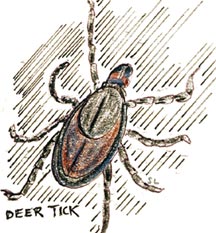
|
 The Plagues of Summer The Plagues of Summer
With West Nile Virus and Lyme Disease to contend with, arm yourself with facts, repellents and long sleeves.
by Sonia Linebaugh
The glorious days are here. Warm weather. Blue skies. Sunshine. Digging in the garden. Hanging in the hammock. Stop. Mosquitoes. Deer ticks. West Nile. Lyme disease. Help. Make it go away.
Sorry. The short story is that you must arm (and leg) yourself with facts, repellents and more clothing than you can bear to think about on a sticky Chesapeake summer evening.
What with war, SARS and slots, I’ve forgotten everything else. Doesn’t West Nile virus have something to do with dead birds?
Yes. West Nile came to public attention in 1999 because of a sudden die-off of crows in the New York area. Eventually 138 species of birds were discovered to be infected with the disease. Dead birds are no longer being collected by health officials now that the range of the disease is known.
Can I get West Nile from a dead bird?
No. Mosquitoes become infected with West Nile when they feed on infected birds. It’s the mosquitoes that carry West Nile virus to humans, from their salivary glands, while biting to take blood.
If I live in an area where birds or mosquitoes with West Nile virus have been reported, will I get the virus if a mosquito bites me?
Probably not. Even in areas where the virus is reported, very few mosquitoes are infected. According to the Centers for Disease Control, fewer than one percent of people bitten by an infected mosquito will get severely ill. The chances of catching West Nile virus from any one mosquito bite are extremely small.

But, if I do get West Nile virus, how will I know?
An infected person may feel symptoms like a mild flu, including a low fever, headache, body aches, skin rash and swollen lymph glands. More serious infections can affect the elderly or others with weak immune systems. Serious symptoms include stiff neck, high fever, disorientation, convulsions and, rarely, death.
What about the other disease, Lyme. Isn’t that a town in Connecticut?
Right. According to the Atlanta-based Centers for Disease Control, Lyme disease was named in 1977 when arthritis was observed in a number of children in and around Lyme, Connecticut. Other symptoms and the local environment led to the discovery that this was an infectious disease carried by an insect.
 Are you talking about the deer tick? Are you talking about the deer tick?
Yes, but don’t put all the blame on deer. Dr. Joseph Horman, public heath veterinarian with Anne Arundel County Health Department, says, “While the adult ticks that carry Lyme disease feed on deer, the microscopic nymphs (larvae) of the tick cause more infections in people. The nymph feeds on white-footed mice, infecting them with Lyme disease. From there the nymphs can move on to feed on other rodents, rabbits, squirrels, dogs and cats.” It’s the smaller rodents that most often carry the disease to humans.
How do I know if I’ve got Lyme disease?
Lyme disease is difficult to diagnose because there may be no symptoms. Or symptoms may mimic other diseases. A bull’s-eye rash of red circles around a clear center is the most common first symptom, appearing from three days to one month after the tick bite. The rash may be warm but is not usually painful. Flu-like symptoms may appear at the same time. Later, symptoms may disappear — or there may be severe headaches, meningitis, facial paralysis, heart irregularities or shortness of breath. Several months or even years later, if Lyme disease is not treated, it can lead to swelling and pain in large joints, especially the knees. If you suspect Lyme disease, see your doctor. It can be treated in the early stages with antibiotics.
When Mark McCaig of Fairhaven had his first bout with Lyme disease six years ago, it remained undiagnosed for some time. Antibiotic treatments finally cleared the case. Then, McCaig developed Type 1 diabetes. To date, a medical correlation has not been made, but McCaig believes that since there is no family history of diabetes, his may result from immune system damage from the Lyme disease.
Can’t we just spray away the mosquitoes and ticks?
There is no spray that controls deer ticks. And there is no vaccine. The Anne Arundel County Heath Department response to Lyme disease is public education on avoiding ticks, according to spokeswoman Elin Jones.
The State Agriculture Department does spray for mosquitoes. But state mosquito spraying is considered “nuisance control,” not disease control. In 2002, the department sprayed 2,000 communities in 22 Maryland counties for mosquitoes.
In general, communities must sign up with the state if they want mosquito spraying. Applications are good for five years. The deadline for first-time spraying is the end of May. Other notoriously mosquito-infested places like Shady Side and Churchton contract directly with the State.
Last year, voluntary spraying was pre-empted by the Anne Arundel County Health Department. Deeming West Nile virus a serious health hazard, the department ordered mosquito spraying as an attempt to ward off an emerging problem. Some communities, including Annapolis, had never before been sprayed.
There are no plans for mandatory spraying this year.
But that could change. V. Wilson Freeland of Calvert County’s mosquito control says West Nile is now considered endemic to Maryland. “That means it’s here to stay,” he says. “And this year, more rain means more mosquitoes. The cooler temperatures have kept things under control so far, but once the sun comes out, the mosquitoes will, too. Right now we’re finding them mostly in flood waters.”
Starting June 1, Freeland’s department will collect mosquitoes at a number of sites and send them to the state Department of Health and Mental Hygiene, where they are separated by species then ground up and tested for evidence of West Nile.
If any pools test positive, the spraying threshold will be lowered. That means spraying will be done even if there are fewer mosquitoes than usual. Larvicides will be used or the infested mosquito pools will be physically destroyed.
What about fish that eat mosquitoes?
Gambusia are often called mosquito fish. They eat mosquito larvae. Because the fish are very aggressive, the Department of Agriculture uses them only in pools of water that are isolated from any other.
“The Gambusia is a native fish,” Freeland says, “but, some of the places we might want to put it to control mosquitoes are not its usual habitat. We’re limited to putting them into storm water pools or ornamental ponds. We still give them away free to Calvert County residents for their ornamental pools.”
 What about repellents? What about repellents?
The County Health Department says, “Spray arms and legs with an insect repellent containing DEET (up to 50 percent for adults, 10 percent for children). Do not use pet flea and tick collars on humans.”
Vitamin B and “ultrasonic” devices are not effective in preventing mosquito bites.
Must we really stay covered up?
It’s a good idea. In tick infested areas, the Health Department advises, “wear light-colored, long-sleeved shirts and long pants tucked into your socks. Inspect your clothing and skin after being in tick territory. Inspect for ticks every three to four hours and at the end of the day. Check the hairline, in the hair and ears and where clothing is snug.”
After two bouts with Lyme disease, McCaig advises, “Our family wears close-toed shoes even in the summer. I grew up running barefoot, so it’s hard. We also check each other daily for any sign of ticks or bull’s-eye marks. When we get into the routine, it goes pretty quickly. It’s just another point of grooming.”
Just how bad is it?
According to Maryland Department of Health, there were 33 human cases of West Nile from nine areas of the state in 2002. Eight of the infected people were from in Anne Arundel County. One death in the county is possibly related to the disease. There were no cases reported in Calvert County. Also in 2002, approximately 6,100 mosquito pools in Maryland were tested, and 46 of them proved positive for West Nile virus. Two of those groups were in Anne Arundel County.
To put Lyme disease and West Nile virus into perspective, consider a few facts from Anne Arundel County Division of Health Statistics. In 2000, heart disease, cancer, stroke and chronic lung disease accounted for 75 percent of recorded deaths in the county. They were followed by diabetes, accidents, flu and pneumonia, Alzheimer’s, bacterial infection and kidney disease.
Now you have the facts. It’s up to you to use the insect repellent and keep your clothes on.
About the Author:
Sonia Linebaugh credits development of her writing and related skills to her years as a New Bay Times writer, assistant editor, graphic designer and illustrator. Today she is a freelance writer, artist and teacher, who lives with her husband near the Bay. Her first book, At the Feet of Mother Meera, will be out this fall. |
 |
 I’ve Been There I’ve Been There
by Cheryl Emery
Four years ago, I thought I had picked up a little poison ivy on the back of my knee. I treated it with the usual topical ointment, and my doctor verified that it was just that. However, when extreme feelings of fatigue, tingling in my hands and memory hesitations became pronounced, it was apparent that I was dealing with more than just poison ivy. The facial paralysis that followed was correctly diagnosed as Bell’s Palsy. The rest of the symptoms were incorrectly diagnosed as multiple sclerosis, as I had actually contracted Lyme disease.
So it’s a particular worry to me that confirmed cases of Lyme disease in Calvert County increased in 2002 by five percent. Anne Arundel County actually decreased by four percent but the State of Maryland overall increased by 17.6% percent.
Over 700 cases of Lyme disease were reported in Maryland in 2002. Chesapeake Country is at high risk for Lyme disease. But many cases of Lyme disease go unreported, Maryland health department officials believe. As a precautionary measure, many doctors are treating possible cases of Lyme more aggressively with antibiotics. These “possible” cases of Lyme disease — even though they may be actual cases — do not require reporting. Thus education and awareness remain your best protection.
|
|


 The Plagues of Summer
The Plagues of Summer
 Are you talking about the deer tick?
Are you talking about the deer tick? What about repellents?
What about repellents?
 I’ve Been There
I’ve Been There